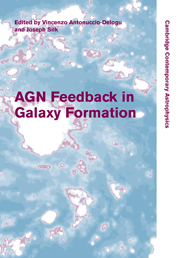Book contents
- Frontmatter
- Contents
- List of contributors
- Preface
- The organising committees
- Part I AGNs, starbursts and galaxy evolution
- 1 The effects of mass and star-formation timescale on galaxy evolution
- 2 Suppressing cluster cooling flows by multiple AGN activity
- 3 Starburst and AGN activity in Spitzer-selected sources at high-z
- 4 Star formation in galaxies hosting active galactic nuclei up to z ∼ 1
- Part II Co-evolution of black holes and galaxies
- Part III Outflows and radio galaxies
- Part IV Models and numerical simulations: methods and results
- Index
4 - Star formation in galaxies hosting active galactic nuclei up to z ∼ 1
from Part I - AGNs, starbursts and galaxy evolution
Published online by Cambridge University Press: 10 November 2010
- Frontmatter
- Contents
- List of contributors
- Preface
- The organising committees
- Part I AGNs, starbursts and galaxy evolution
- 1 The effects of mass and star-formation timescale on galaxy evolution
- 2 Suppressing cluster cooling flows by multiple AGN activity
- 3 Starburst and AGN activity in Spitzer-selected sources at high-z
- 4 Star formation in galaxies hosting active galactic nuclei up to z ∼ 1
- Part II Co-evolution of black holes and galaxies
- Part III Outflows and radio galaxies
- Part IV Models and numerical simulations: methods and results
- Index
Summary
Introduction
This contribution aims to address the fundamental question, effectively highlighting the overall theme of the workshop, as to what processes are important for eventually suppressing the growth of supermassive black holes (SMBHs) and how is this related to the evolution of star formation from z ∼ 1 to the present. As illustrated in Figure 4.1, a global decline in mass accretion onto SMBHs and star formation rate density over the last 8 Gyr (Boyle and Terlevich 1998; Merloni 2004; Silverman et al. 2008b) is evident and may be driven by a mechanism such as feedback from AGN affecting the gas content of their hosts (Granato et al. 2004; Hopkins et al. 2008; Silk and Norman 2009). Such coupling may not only explain the local SMBH–bulge relations (see Shankar 2009 for an overview) but rectify the inconsistency between the observed distribution of high-mass galaxies and that predicted by semi-analytic models (Croton et al. 2006). Intriguingly, there is observational evidence for AGNs influencing their larger-scale environments that may lend support for the aforementioned feedback models. For example, radio jets are capable of impacting their intracluster medium, (Fabian et al. 2006) which may then in turn regulate further cluster cooling and inhibit star formation in the AGN host galaxy itself (Rafferty et al. 2008). Even at low power, radio-emitting outflows are capable of redistributing line-emitting gas in galactic nuclei (Whittle and Wilson 2004).
- Type
- Chapter
- Information
- AGN Feedback in Galaxy Formation , pp. 29 - 38Publisher: Cambridge University PressPrint publication year: 2010

